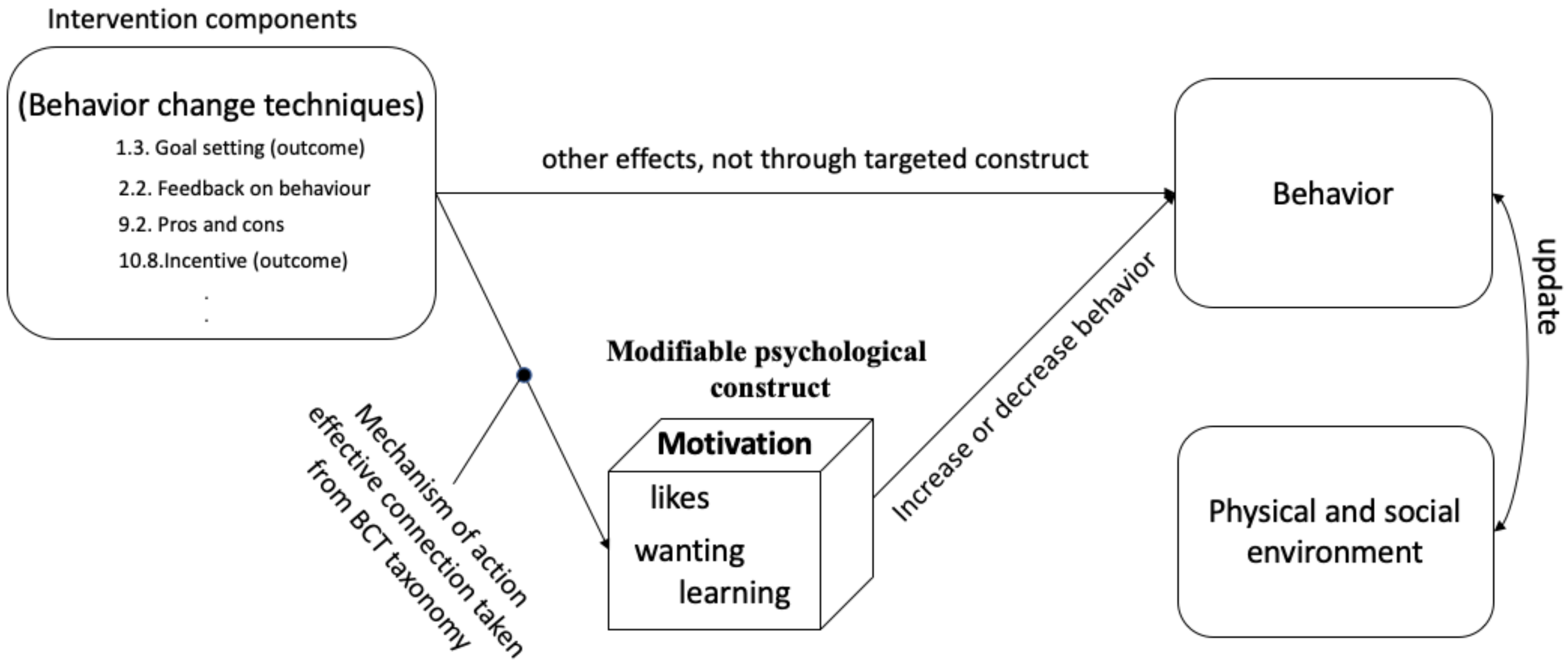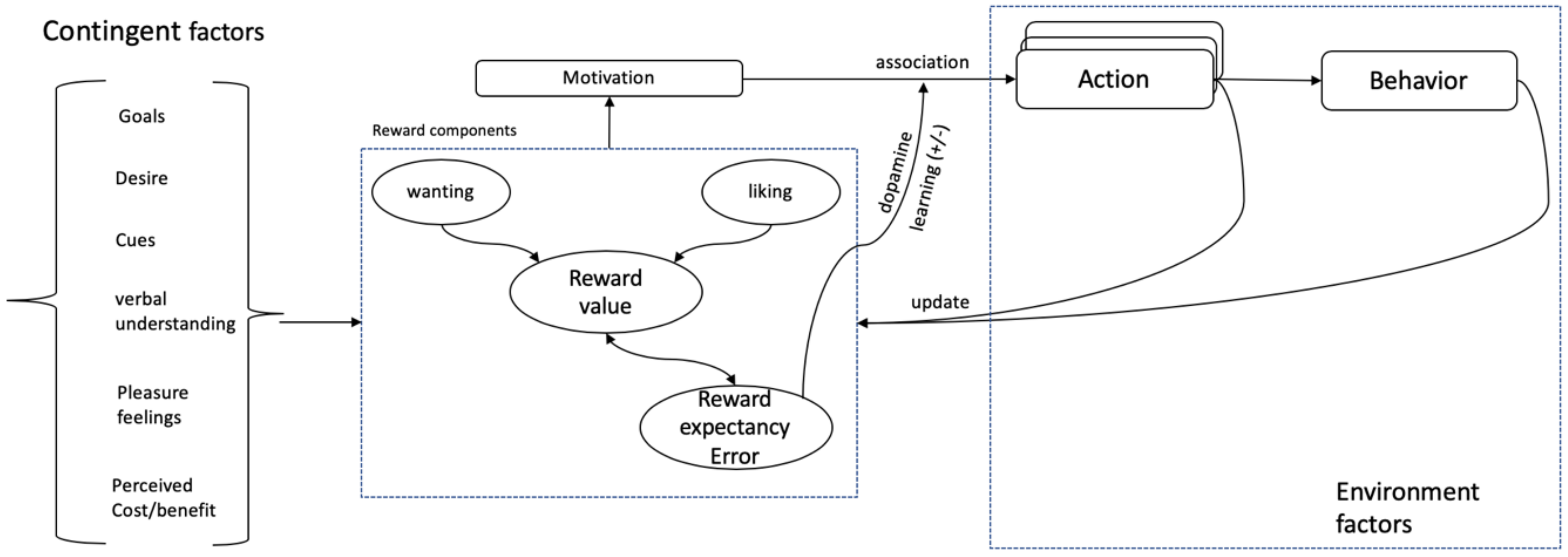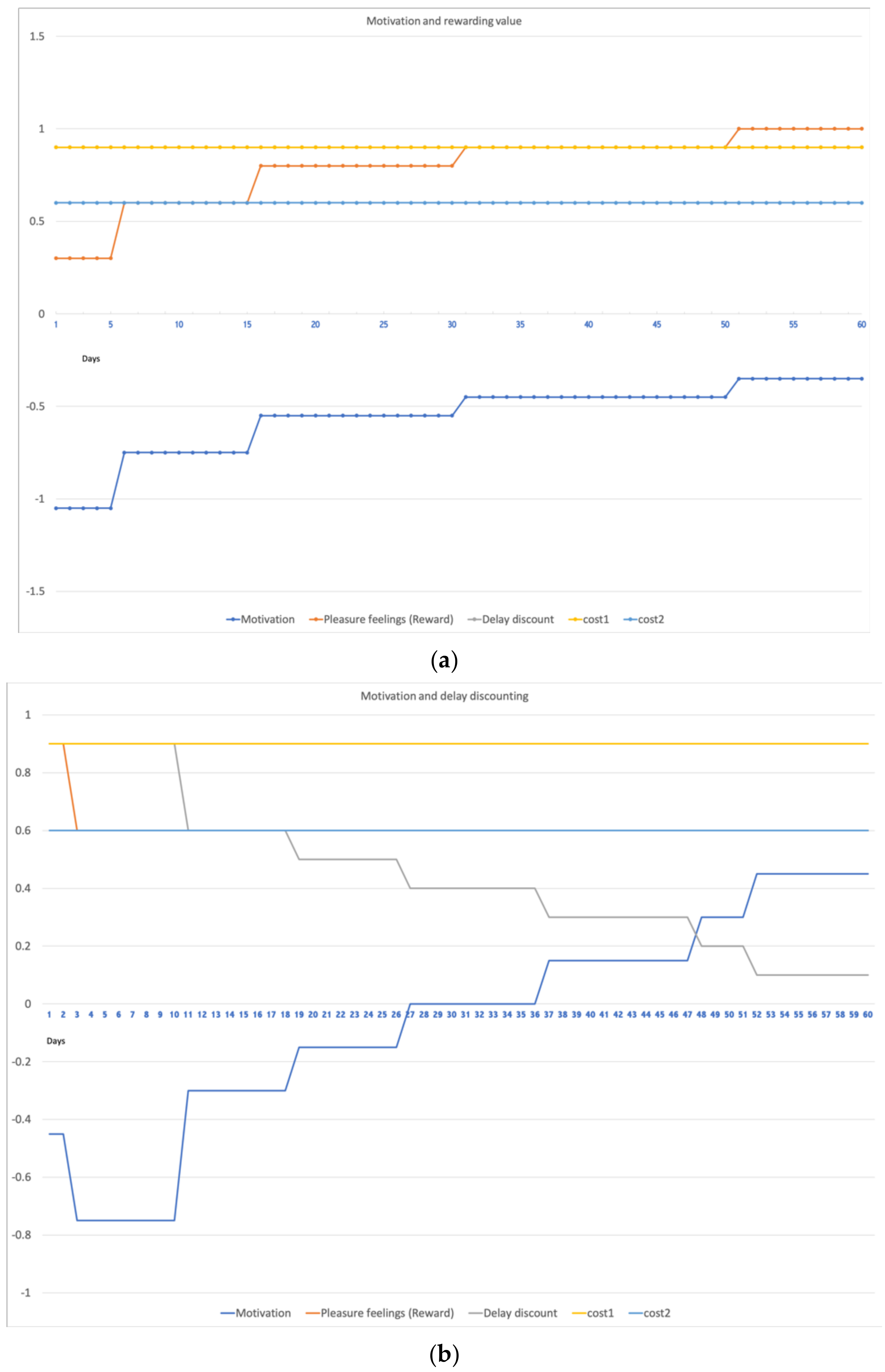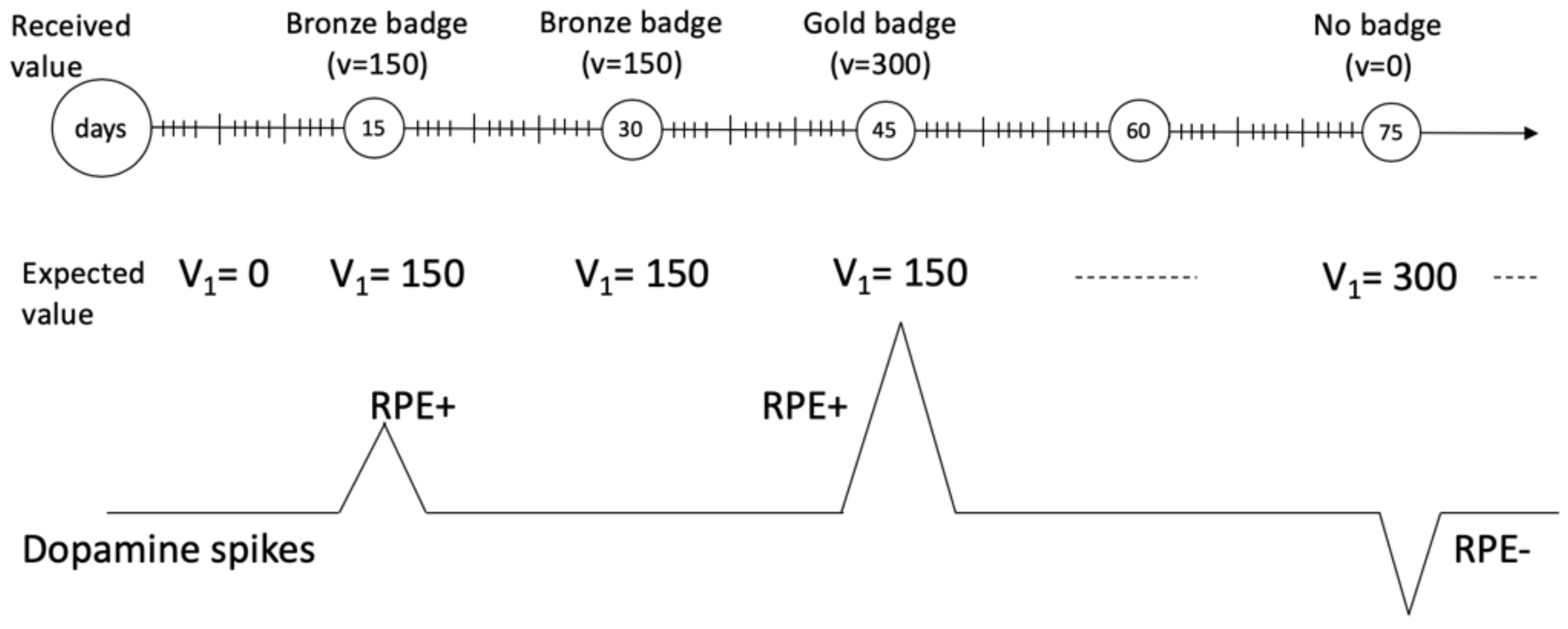Motivating Machines: The Potential of Modeling Motivation as MoA for Behavior Change Systems
Abstract
:1. Introduction
- To propose a formal description of the dynamics of motivation and a computational implementation to show its working as a ‘mechanism of action’ component in digital behavior change intervention.
- To illustrate the relevance of the model for the study of digital behavior change interventions, specifically for generating and maintaining motivation, and how this can be used for personalization and adaption of interventions.
2. Health Behavior Change and Motivation
2.1. Motivation Generation
2.1.1. Liking vs. Wanting
2.1.2. Action Control Systems
2.2. Motivation Maintenance
2.3. Behavior Change Techniques for Motivation Generation and Maintenance
3. Why and How to Model ‘Mechanism of Actions’
3.1. Temporal Causal Network Models
3.2. Multidimensional Generalization Space
3.3. Computational Agent/System Models
4. Model Description and Formalization
- What strategies can be used to increase the rewarding value of a stimulus? Increasing the anticipated value of the stimulus (any behavior, goal, etc.) will be assumed that motivation is generated, and the behavior will be performed more often because of the enriching value.
- What strategies can be used to keep the RPE as positive as possible, as the association between stimulus-reward will be learned when the RPE is positive. In the case of negative RPE, the learning would get slow or stop, and eventually, the chances are that an agent will switch to perform other behavior for greater reward.
4.1. Value-Based Reward Anticipation for Motivation Generation
4.2. Reward Prediction Error for Motivation Maintenance
5. Motivation-Based Intervention Example and Simulations
“The office management announced a 3-month program for employees to make them physically active. The organization targeted motivation as a core psychological construct for changing behavior. The employees are asked to subscribe, and they are provided digital wearable devices that can count their daily physical activities. The program is designed to use performance-based incentives to activate the dopamine reward pathway. When the stimuli (physical activity) are cognitively processed, it becomes a goal. The first technique to generate motivation is to give incentives for goal achievement. For this reason, after every 15 days, the incentive will be given according to the choices toward the goal. The goal is to increase the rewarding value of physical activity and overcome its costs. Furthermore, the reward prediction error will be calculated to maintain motivation to change strategies and determine the motivation level. Every component and process of the intervention is described in the concerned sector below.”
5.1. Motivation Generation
5.2. Motivation Maintenance
Positive Reward Prediction Error
6. Conclusions
7. Limitations and Future Work
Author Contributions
Funding
Institutional Review Board Statement
Informed Consent Statement
Data Availability Statement
Conflicts of Interest
References
- Peters, G.-J. Constructs, Operationalisations, Mediators, and Why Behavior Change Techniques Cannot Change Behavior. Available online: https://behaviorchange.eu/2018/06/constructs-operationalisations-mediators-and-why-behavior-change-techniques-cannot-change-behavior/ (accessed on 20 April 2022).
- Michie, S.; Yardley, L.; West, R.; Patrick, K.; Greaves, F. Developing and Evaluating Digital Interventions to Promote Behavior Change in Health and Health Care: Recommendations Resulting From an International Workshop. J. Med. Internet Res. 2017, 19, e232. [Google Scholar] [CrossRef] [PubMed]
- Taj, F.; A Klein, M.C.; van Halteren, A. Digital Health Behavior Change Technology: Bibliometric and Scoping Review of Two Decades of Research. JMIR mHealth uHealth 2019, 7, e13311. [Google Scholar] [CrossRef] [PubMed]
- Hekler, E.B.; Michie, S.; Pavel, M.; Rivera, D.; Collins, L.; Jimison, H.B.; Garnett, C.; Parral, S.; Spruijt-Metz, D. Advancing Models and Theories for Digital Behavior Change Interventions. Am. J. Prev. Med. 2016, 51, 825–832. [Google Scholar] [CrossRef] [PubMed] [Green Version]
- Michie, S.; Thomas, J.; John, S.-T.; Mac Aonghusa, P.; Shawe-Taylor, J.; Kelly, M.P.; Deleris, L.A.; Finnerty, A.N.; Marques, M.M.; Norris, E.; et al. The Human Behaviour-Change Project: Harnessing the power of artificial intelligence and machine learning for evidence synthesis and interpretation. Implement. Sci. 2017, 12, 121. [Google Scholar] [CrossRef] [PubMed] [Green Version]
- Connell, L.E.; Carey, R.N.; de Bruin, M.; Rothman, A.J.; Johnston, M.; Kelly, M.P.; Michie, S. Links Between Behavior Change Techniques and Mechanisms of Action: An Expert Consensus Study. Ann. Behav. Med. 2018, 53, 708–720. [Google Scholar] [CrossRef] [PubMed] [Green Version]
- Taj, F.; Klein, M.C.A.; van Halteren, A. Computational model for reward-based generation and maintenance of motivation. In Brain Informatics; Lecture Notes in Computer Science (including Subseries Lecture Notes in Artificial Intelligence and Lecture Notes in Bioinformatics); Springer: Cham, Switzerland, 2018; Volume 11309, pp. 41–51. [Google Scholar]
- Prochaska, J.O.; Velicer, W.F. The Transtheoretical Model of Health Behavior Change. Am. J. Health Promot. 1997, 12, 38–48. [Google Scholar] [CrossRef] [PubMed]
- Schwarzer, R.; Luszczynska, A. How to Overcome Health-Compromising Behaviors. Eur. Psychol. 2008, 13, 141–151. [Google Scholar] [CrossRef]
- Bouffard, L. Review of Ryan, R.M.; Deci, E.L. (2017). Self-determination theory. Basic psychological needs in motivation, development and wellness. New York, NY: Guilford Press. Rev. Québécoise Psychol. 2017, 38, 231. [Google Scholar]
- Berridge, K.C.; Robinson, T.E. Liking, wanting, and the incentive-sensitization theory of addiction. Am. Psychol. 2016, 71, 670–679. [Google Scholar] [CrossRef] [PubMed]
- Vlaev, I.; Dolan, P. Action Change Theory: A Reinforcement Learning Perspective on Behavior Change. Rev. Gen. Psychol. 2015, 19, 69–95. [Google Scholar] [CrossRef]
- Diederen, K.M.J.; Fletcher, P.C. Dopamine, Prediction Error and Beyond. Neuroscientist 2020, 27, 30–46. [Google Scholar] [CrossRef] [PubMed]
- Michie, S.; Richardson, M.; Johnston, M.; Abraham, C.; Francis, J.; Hardeman, W.; Eccles, M.P.; Cane, J.; Wood, C.E. The behavior change technique taxonomy (v1) of 93 hierarchically clustered techniques: Building an international consensus for the reporting of behavior change interventions. Ann. Behav. Med. 2013, 46, 81–95. [Google Scholar] [CrossRef] [PubMed]
- Locke, E.A.; Latham, G.P. Goal setting theory. In Motivation: Theory and Research; Routledge: London, UK, 2012; pp. 23–40. [Google Scholar]
- Taj, F.; Ullah, N.; Klein, M. Computational model for changing sedentary behavior through cognitive beliefs and introspective body-feelings. In Proceedings of the 14th International Joint Conference on Biomedical Engineering Systems and Technologies, Online Streaming, 11–13 February 2021; pp. 443–450. [Google Scholar]
- Ullah, N.; Klein, M.; Treur, J. Food Desires, Negative Emotions and Behaviour Change Techniques: A Computational Analysis. Smart Cities 2021, 4, 48. [Google Scholar] [CrossRef]
- Taj, F.; Klein, M.; van Halteren, A. An agent-based framework for persuasive health behavior change intervention. In Health Information Science; Lecture Notes in Computer Science (including Subseries Lecture Notes in Artificial Intelligence and Lecture Notes in Bioinformatics); Springer: Cham, Switzerland, 2020; Volume 12435, pp. 157–168. [Google Scholar]
- Mollee, J.S.; van der Wal, C.N. A computational agent model of influences on physical activity based on the social cognitive theory. In Proceedings of the International Conference on Principles and Practice of Multi-Agent Systems, Nagoya, Japan, 18–20 November 2013; pp. 478–485. [Google Scholar]
- Riley, W.; Martin, C.; Rivera, D.; Hekler, E.; Buman, M.; Adams, M.; Pavel, M. The development of a control systems model of social cognitive theory. Ann. Behav. Med. 2014, 47, S149. [Google Scholar]
- Klein, M.; Mogles, N.; van Wissen, A. Why won’t you do what’s good for you? Using intelligent support for behavior change. In Proceedings of the International Workshop on Human Behavior Understanding, Amsterdam, The Netherlands, 16 November 2011; pp. 104–115. [Google Scholar]
- Verharen, J.P.H.; Adan, R.A.H.; Vanderschuren, L.J.M.J. How Reward and Aversion Shape Motivation and Decision Making: A Computational Account. Neuroscientist 2019, 26, 87–99. [Google Scholar] [CrossRef] [PubMed]
- Jarmolowicz, D.P.; Cherry, J.C.; Reed, D.; Bruce, J.M.; Crespi, J.M.; Lusk, J.L.; Bruce, A.S. Robust relation between temporal discounting rates and body mass. Appetite 2014, 78, 63–67. [Google Scholar] [CrossRef] [PubMed] [Green Version]
- Larsen, K.R.; Michie, S.; Hekler, E.B.; Gibson, B.; Spruijt-Metz, D.; Ahern, D.; Cole-Lewis, H.; Ellis, R.J.B.; Hesse, B.; Moser, R.P.; et al. Behavior change interventions: The potential of ontologies for advancing science and practice. J. Behav. Med. 2016, 40, 6–22. [Google Scholar] [CrossRef] [PubMed] [Green Version]




| (Code). Behavior Change Techniques | Purpose | Reward System Components |
|---|---|---|
| 1.3. Goal setting (outcome) | For planning, reduce gratification, frustration | Maintain reward prediction error |
| 9.2. Pros and Cons | Increase wanting (pros) and not wanting (cons) | Wanting |
| 10.8. Incentive (outcome) | Increase outcome value | Liking |
| 10.10. Reward (outcome) | Increase outcome value | Liking |
| Motivation Processes | Targeted Behavior | Sub-Processes in the Motivation Model | BCTs | MoA | Environmental Observations |
|---|---|---|---|---|---|
| Motivation Generation | Physical Activity | Value-Based Reward Anticipation | 10.8 Incentive (outcome) 5.1 Information about health consequences | Motivation | Step count, feelings (hedonic pleasure) |
| Motivation Maintenance | Reward-Prediction Error | 1.3 Goal setting (outcome) |
Publisher’s Note: MDPI stays neutral with regard to jurisdictional claims in published maps and institutional affiliations. |
© 2022 by the authors. Licensee MDPI, Basel, Switzerland. This article is an open access article distributed under the terms and conditions of the Creative Commons Attribution (CC BY) license (https://creativecommons.org/licenses/by/4.0/).
Share and Cite
Taj, F.; Klein, M.C.A.; Van Halteren, A. Motivating Machines: The Potential of Modeling Motivation as MoA for Behavior Change Systems. Information 2022, 13, 258. https://doi.org/10.3390/info13050258
Taj F, Klein MCA, Van Halteren A. Motivating Machines: The Potential of Modeling Motivation as MoA for Behavior Change Systems. Information. 2022; 13(5):258. https://doi.org/10.3390/info13050258
Chicago/Turabian StyleTaj, Fawad, Michel C. A. Klein, and Aart Van Halteren. 2022. "Motivating Machines: The Potential of Modeling Motivation as MoA for Behavior Change Systems" Information 13, no. 5: 258. https://doi.org/10.3390/info13050258
APA StyleTaj, F., Klein, M. C. A., & Van Halteren, A. (2022). Motivating Machines: The Potential of Modeling Motivation as MoA for Behavior Change Systems. Information, 13(5), 258. https://doi.org/10.3390/info13050258






